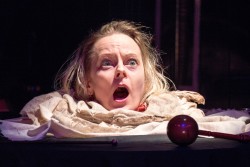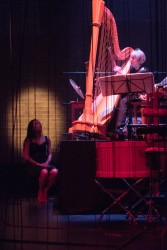 How to approach a massive work that may put off potential audiences by coming off as a wee bit megalomaniac? You distil it, and stage the highlights as a piece unto itself, is the lesson to take from Laurence Cherney’s selection of parts from R. Murray Schafer’s Patria cycle into Odditorium, which opened on March 2 at the Crow’s Theatre. Schafer’s Patria is a decades-long project consisting of a dozen works that follow a hero and a heroine in various disguises through the mythology of the ancient Crete and Egypt and even further through the Schafer-authored mythologies, but for this occasion Cherney, Schafer’s frequent collaborator, wisely chose four excerpts only, and invited director Chris Abraham and dancer Andrea Nann to find the red thread.
How to approach a massive work that may put off potential audiences by coming off as a wee bit megalomaniac? You distil it, and stage the highlights as a piece unto itself, is the lesson to take from Laurence Cherney’s selection of parts from R. Murray Schafer’s Patria cycle into Odditorium, which opened on March 2 at the Crow’s Theatre. Schafer’s Patria is a decades-long project consisting of a dozen works that follow a hero and a heroine in various disguises through the mythology of the ancient Crete and Egypt and even further through the Schafer-authored mythologies, but for this occasion Cherney, Schafer’s frequent collaborator, wisely chose four excerpts only, and invited director Chris Abraham and dancer Andrea Nann to find the red thread.
And threads were very much in evidence in the modest but effective set (Shannon Lea Doyle), as they are used to outline the walls of the labyrinth with the mannequin body parts of those who did not manage to find the exit piled up in corners. The overarching theme therefore came from the final, best known and multiple times recorded The Crown of Ariadne (1979), an elaboration on the myth of Ariadne, the Minotaur and Theseus through the voice of the harp and a series of percussive instruments. The Crown was originally written for Judy Loman, who plays it (fair to say, performs it) compellingly in Odditorium. There’s drama in the procession of unexpected soundscapes and instrument pairings of this piece, of course, but there’s additional drama in observing the demands on the musician, the extravagant arm movements and the comings and goings of smaller instruments while the other hand is always on the harp. It’s a good choice for the end piece.
The preceding two, Tantrika (1986) and an Egyptian fantasy Amente-Nufe (1982) involve a mezzo-soprano and impressive sets of percussions – again, the prominent instruments are themselves part of the set. Mezzo Andrea Ludwig, always charismatic, produces an endless variety of extended technique sounds, moves around, handles the odd percussive task and employs acting where acting is required: in the tantric piece, for example, she observes, perhaps voices, the male-female dance of merging and separation (Nann with Brendan Wyatt centre stage). In Amente-Nufe from the section of Patria called Ra, the singer voices words in what a scholarly guess says the Middle Egyptian might have sounded like, but feel free to ignore this backdrop: the words are best taken in for the texture of their sounds, not for their meaning. The culmination of the segment, with all the gongs and bells going full blast, is an experience rarely available in concert halls – or houses of religious worship. Ryan Scott and Daniel Morphy manned the considerable assortment of percussions (including gamelan) throughout the show with tireless focus and aplomb.
It all started with a scene best described as Felliniesque: the accordionist (Joseph Macerollo, in clown makeup) trots onto the stage and uncovers a severed head that speaks. Well, speaks: voices outrageous sounds is more accurate, as there are no words, but quite a lot of conversation happening between the accordion and the soprano head (belonging to the crystalline-voiced Carla Huhtanen). It’s a funny, charming opening to a performance that gets pretty serious immediately after.
 Yes, but what does it all mean, you may ask? A question best left home for the occasion, I think. It’s slippery to pin meaning to music at the best of times, and this electrifying selection of oddities really rubs it in. It’s an immersive trip into what humans can do with their voices and their hands operating on metal, wood, strings and boxed air.
Yes, but what does it all mean, you may ask? A question best left home for the occasion, I think. It’s slippery to pin meaning to music at the best of times, and this electrifying selection of oddities really rubs it in. It’s an immersive trip into what humans can do with their voices and their hands operating on metal, wood, strings and boxed air.
Still, Odditorium is an open work so should you need to, you may work out your own narrative out of it. Given its four prominent and very different women—a dancer, a virtuoso harpist, high- and low-voiced singers—the piece may indeed cohere, as Andrea Ludwig suggested after the opening night show, as an enactment of female empowerment. The world of classical music still leaves too little room for that, and any occasion that resembles it should be welcomed.
Or you can approach it as a ritual of sorts—a non-religious one. Schafer composed most of the Patria in 12-tone, and the unpinnable micro-intervals heard in Odditorium and the vocal acrobatics that evoke wonder rather than beauty keep the work refreshingly unfamiliar. And though your mind may drift in and out of it, it’s music that doesn’t lull you, but keeps the cogs turning and surprise in steady supply.
Soundstreams’ Odditorium opened on March 2 continues through March 5 (times vary), at Crow’s Theatre in Toronto. Details in our listings and at https://www.soundstreams.ca/performances/main-stage/r-murray-schafers-odditorium/.
Lydia Perović is an arts journalist in Toronto. Send her your art-of-song news to artofsong@thewholenote.com.


